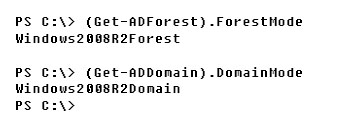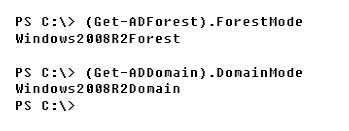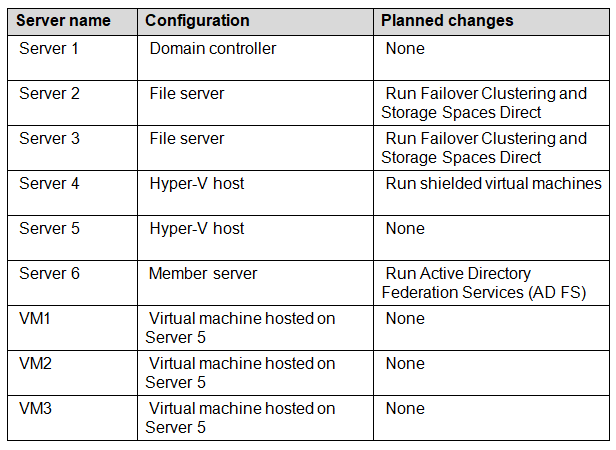Microsoft Upgrading Your Skills to MCSA: Windows Server 2016 70-743 Exam Practice Test
Note: This question is part of a series of questions that present the same scenario. Each question in the series contains a unique solution that might meet the stated goals. Some questions sets might have more than one correct solutions, while others might not have a correct solution.
After you answer a question in this section, you will NOT be able to return to it. As a result, these questions will not appear in the review screen.
Your network contains an Active Directory forest named contoso.com. The forest contains a member server named Server1 that runs Windows Server 2016. All domain controllers run Windows Server 2012 R2.
Contoso.com has the following configuration:

You plan to deploy an Active Directory Federation Services (AD FS) farm on Server1 and to configure device registration.
You need to configure Active Directory to support the planned deployment.
Solution: You run adprep.exe from the Windows Server 2016 installation media.
Does this meet the goal?
Answer : B
Device registration requires a forest functional level of Windows Server 2012 R2.
New installations of AD FS 2016 require the Active Directory 2016 schema (minimum version 85).
References:
https://technet.microsoft.com/en-us/library/dd464018(v=ws.10).aspx
Note: This question is part of a series of questions that present the same scenario. Each question in the series contains a unique solution. Determine whether the solution meets the stated goals.
Your network contains an Active Directory domain named contoso.com. The domain contains a DNS server named Server1. All client computers run Windows 10.
On Server1, you have the following zone configuration.

You need to ensure that all of the client computers in the domain perform DNSSEC validation for the fabrikam.com namespace.
Solution: From a Group Policy object (GPO) in the domain, you add a rule to the Name Resolution Policy Table (NRPT).
Does this meet the goal?
Answer : A
The NRPT stores configurations and settings that are used to deploy DNS Security Extensions (DNSSEC), and also stores information related to DirectAccess, a remote access technology.
Note: The Name Resolution Policy Table (NRPT) is a new feature available in Windows Server 2008 R2. The NRPT is a table that contains rules you can configure to specify DNS settings or special behavior for names or namespaces. When performing DNS name resolution, the DNS Client service checks the NRPT before sending a DNS query. If a DNS query or response matches an entry in the NRPT, it is handled according to settings in the policy. Queries and responses that do not match an NRPT entry are processed normally.
References:
https://technet.microsoft.com/en-us/library/ee649207(v=ws.10).aspx
You have a remote access server named Server1 that runs Windows Server 2016. Server1 has DirectAccess enabled.
You have a proxy server named Server2. All computers on the internal network connect to the Internet by using the proxy.
On Server1, you run the command Set-DAClient -forceTunnel Enabled.
You need to ensure that when a DirectAccess client connects to the network, the client accesses all the Internet resources through the proxy.
What should you run on Server1?
Answer : B
Note: This question is part of a series of questions that present the same scenario. Each question in the series contains a unique solution that might meet the stated goals. Some questions sets might have more than one correct solutions, while others might not have a correct solution.
After you answer a question in this section, you will NOT be able to return to it. As a result, these questions will not appear in the review screen.
Your network contains an Active Directory forest named contoso.com. The forest contains a member server named Server1 that runs Windows Server 2016. All domain controllers run Windows Server 2012 R2.
Contoso.com has the following configuration:

You plan to deploy an Active Directory Federation Services (AD FS) farm on Server1 and to configure device registration.
You need to configure Active Directory to support the planned deployment.
Solution: You raise the forest (domain) functional level to Windows Server 2012 R2.
Does this meet the goal?
Answer : B
For a Windows Server 2012 R2 AD FS server, this solution would work. However, new installations of AD FS 2016 require the Active Directory 2016 schema (minimum version 85).
References:
Note: This question is part of a series of questions that use the same scenario. For your convenience, the scenario is repeated in each question. Each question presents a different goal and answer choices, but the text of the scenario is exactly the same in each question in this series.
Start of repeated scenario
Your network contains an Active Directory domain named contoso.com. The functional level of the forest and the domain is Windows Server 2008 R2. All servers in the domain run Windows Server 2016 Standard. The domain contains 300 client computers that run either Windows 8.1 or Windows 10.
The domain contains nine servers that are configured as shown in the following table.

The virtual machines are configured as follows:
* Each virtual machine has one virtual network adapter.
* VM1 and VM2 are part of a Network Load Balancing (NLB) cluster.
* All of the servers on the network can communicate with all of the virtual machines.
End of repeated scenario.
You plan to implement nested virtual machines on VM1.
Which two features will you be prevented from using for VM1?
Answer : C
You have an Active Directory domain named contoso.com.
The computers in contoso.com are installed by using Windows Deployment Services.
You have a server named Server1 that runs Windows Server 2016. Server1 is a member of contoso.com. Server1 has the Hyper-V role installed. Virtual machines on Server1 are connected to an external switch named Switch1.
You create a virtual machine named VM1 on Server1 by running the following cmdlets.

You need to ensure that you can install the operating system on VM1 by using Windows Deployment Services.
What should you do?
Answer : A
A legacy network adapter is required for PXE boot.
Not B: The switch is an External switch which is what is required.
Note: This question is part of a series of questions that use the same or similar answer choices. An answer choice may be correct for more than one question in the series. Each question is independent of the other questions in this series. Information and details provided in a question apply only to that question.
You have a two-node Hyper-V cluster named Cluster1.
A virtual machine named VM1 runs on Cluster1.
You need to configure monitoring of VM1. The solution must move VM1 to a different node if the Print Spooler service on VM1 stops unexpectedly.
Which tool should you use?
Answer : F